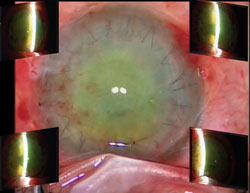Sandwich technique for amniotic membrane transplantation with fibrin glue reduces surgical time
 Thomas John |
Amniotic membrane transplantation is a useful adjunctive surgical procedure in the management of various ocular surface disease states. However, transplantation adds to the overall cost of the surgical procedure. Alternatively, conjunctival autograft can be used when possible.
Recently, some surgeons are moving to replace sutures with fibrin glue, which can shorten the surgical time for this procedure. There are various techniques for fibrin glue application, including the twin-barrel delivery approach and separate application of two components to the ocular surface bed and to the stromal side of the amniotic membrane. In the latter technique, the membrane is then flipped over, such that the stromal side of the amniotic membrane faces the ocular surface, and attached to the ocular surface.
In this column, I describe the sandwich technique of applying fibrin glue followed by uniform surface pressure for smooth attachment of the membrane to the ocular surface in surgery for pterygium and persistent corneal epithelial defect.
Pterygium excision
The globe is rotated temporally using 6-0 silk sutures (Figure 1, upper left), and low-temperature disposable eye cautery is used to apply multiple spots on the conjunctival surface, at a distance of 5 mm from the limbus, to demarcate the excisional limits of the procedure (Figure 1, upper right), as I previously reported. Methylene blue highlights the spot cautery marks on the conjunctival surface (Figure 1, lower left). The pterygium is then dissected off of the scleral surface using blunt and sharp dissection (Figure 1, lower right). Hemostasis is achieved using an eraser type of cautery (Figure 2, upper left). Next, a curved hemostat is used to grasp the pterygium, and it is peeled off of the ocular surface from the scleral side to the corneal side in a single smooth, sweeping motion (Figure 2, upper right and inserts). The limbus is smoothed using a straight crescent blade. Human amniotic membrane is then placed on the ocular surface with the stromal side down to cover the bare sclera and the corneal surface that is devoid of epithelium (Figure 2, lower left). Amniotic membrane is attached to the episcleral tissue at four corners using interrupted 10-0 Vicryl sutures (Figure 2, lower right).
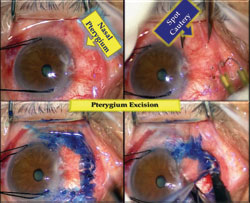 Figure 1. Upper left: Globe is rotated temporally with bridle silk sutures attached to the peripheral cornea providing access to the nasal pterygium. Upper right: Spot cautery being applied using a low-temperature, disposable cautery at a distance of 5 mm from the limbus. Lower left: Methylene blue highlights the spot cautery marks. Lower right: Blunt and sharp dissection of the scleral aspect of the nasal pterygium. |
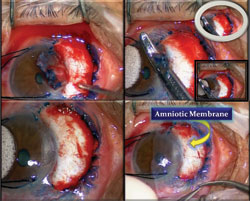 Figure 2. Upper left: Hemostasis is achieved using an eraser type of cautery. Upper right and inserts: Using a curved hemostat, the pterygium is peeled off the ocular surface from the scleral side to the corneal side in a single smooth, sweeping motion. Lower left: Amniotic membrane is placed over the surgical site with the stromal side down. Lower right: Amniotic membrane covers the bare sclera and the peripheral cornea, and it is attached at the corners to the episcleral tissue with interrupted 10-0 Vicryl sutures. Images: John T |
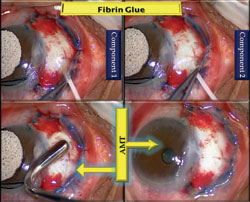 Figure 3. Upper left. Component 1 of the fibrin glue is injected in the interface of the sandwich, comprising the amniotic membrane anteriorly and the sclera and cornea posteriorly. Upper right: Component 2 of the fibrin glue is injected in the interface of the sandwich, resulting in an anterior bulge of the peripherally attached amniotic membrane. Lower left: The flat portion of the muscle hook is used to iron out the amniotic membrane, causing the two components of the fibrin glue to mix within the interface of the sandwich, thus attaching the amniotic membrane to the scleral and corneal surface and extruding out the excess fibrin glue. Lower right: Completed view of pterygium excision with amniotic membrane transplant. |
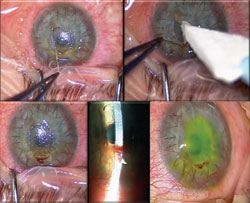 Figure 4. Upper row: Loose, nonadherent epithelium surrounding the persistent corneal epithelial defect is removed. Lower left: Frontal view of the enlarged epithelial defect in a corneal graft. Lower middle: Intraoperative slit lamp view of the surface of the corneal graft. Lower right: Fluorescein highlights the epithelial defect. |
The first component of the fibrin glue (Tisseel, Baxter) is injected into the interface of the sandwich, comprising the amniotic membrane anteriorly and the sclera and cornea posteriorly (Figure 3, upper left). Next, the second component of the fibrin glue is injected into the interface, resulting in an anterior bulge of the peripherally attached amniotic membrane (Figure 3, upper right). A muscle hook is used to iron out the amniotic membrane, causing the two components of the fibrin glue to mix within the interface of the sandwich, thus attaching the amniotic membrane to the scleral and corneal surfaces (Figure 3, lower left). The completed view of this procedure is shown in Figure 3, lower right.
Persistent corneal epithelial defect
Loose, nonadherent epithelium surrounding the persistent corneal epithelial defect is removed (Figure 4, upper row). Next, the amniotic membrane is placed with the stromal side down on the corneal surface and attached to the episcleral tissue at four corners using 10-0 Vicryl sutures (Figure 5, insert). Both components of the fibrin glue are sequentially injected into the sandwich interface, and the amniotic membrane is attached to the corneal surface by gentle compression and a circular gliding movement on the corneal surface using the John ALK Compression Disc (ASICO) (Figures 5 and 6). This mixes the two components of the fibrin glue and firmly attaches the amniotic membrane onto the cornea (Figure 7).
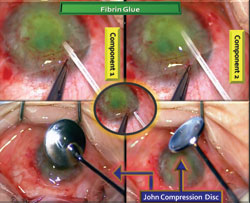 Figure 5. Center Insert: Amniotic membrane is attached to the corneal surface at four sites with 10-0 Vicryl sutures and the tip of the applicator is visible with fibrin glue. Top left: Component 1 of the fibrin glue is injected into the interface of the sandwich comprising the amniotic membrane anteriorly and the corneal surface posteriorly. Top right: Component 2 of the fibrin glue is injected into the interface of the sandwich raising the amniotic membrane in a convex manner. Lower row: Front and back surfaces of the John ALK Compression Disc are shown. The concavity of the rear surface of the compression disc is fairly complementary to the anterior corneal curvature. |
 Figure 6. John ALK Compression Disc is used to gently massage the anterior surface of the amniotic membrane in a clockwise circular motion to help uniformly attach the stromal surface of the amniotic membrane to the anterior corneal surface and facilitate the mixing of the two components of the fibrin glue. |
|
|
Key points
- Firmly grasp the pterygium with the hemostat prior to peeling the tissue off of the ocular surface.
- Place the amniotic membrane with its stromal side down.
- Remove loose, nonadherent corneal epithelium before attaching the amniotic membrane.
- Apply uniform pressure using the muscle hook or the John ALK Compression Disc to facilitate uniform attachment of the amniotic membrane to the ocular surface.
- Remove excess glue from the field.
References:
- Bouchard CS, John T. Amniotic membrane transplantation in the management of severe ocular surface disease: indications and outcomes. Ocul Surf. 2004;2(3):201-211.
- Jain AK, Bansal R, Sukhija J. Human amniotic membrane transplantation with fibrin glue in management of primary pterygia: a new tuck-in technique. Cornea. 2008;27(1):94-99.
- John T. Pterygium excision and conjunctival mini-autograft: preliminary report. Eye (Lond). 2001;15(Pt 3):292-296.
- Seitz B, Das S, Sauer R, Mena D, Hofmann-Rummelt C. Amniotic membrane transplantation for persistent corneal epithelial defects in eyes after penetrating keratoplasty. Eye (Lond). 2009;23(4):840-848.
- Thomas John, MD, is a clinical associate professor at Loyola University at Chicago and is in private practice in Oak Brook, Tinley Park and Oak Lawn, Ill. He can be reached at 708-429-2223; fax: 708-429-2226; e-mail: tjcornea@gmail.com. Dr. John receives a small royalty from ASICO.

